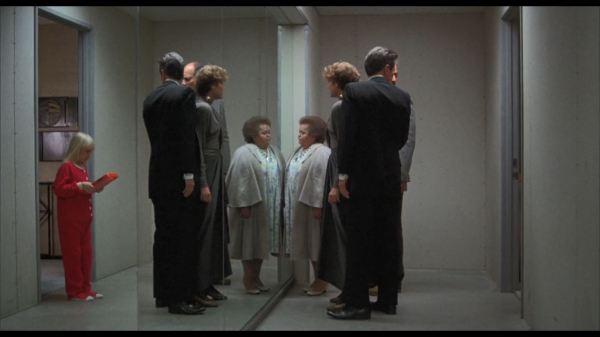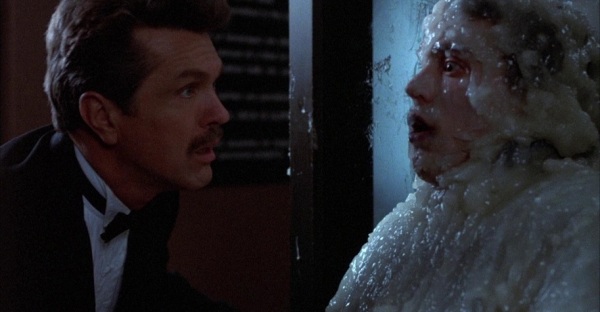John’s Horror Corner: Poltergeist III (1988), a satisfying close to the Poltergeist franchise, even if a bit more random.
MY CALL: This “part III” features great characters, a wild diversity of special effects gags, and a well-earned creepy distrust for mirrors. I find it highly rewatchable, very fun, a bit jumpy and quite satisfying. MORE MOVIES LIKE Poltergeist III: For more “high-rise horror” or “trapped in a building with evil”, consider Shivers (1975), Dawn of the Dead (1978), Demons (1985), Demons 2 (1986), The Dark Tower (1989), Shakma (1990), Demon Knight (1995), Feast (2005), [REC] (2007), Quarantine (2008), Evil Dead Rise (2023) or Infested (2023). An unrelated recommendation, Lights Out (2016) is to light switches what Poltergeist III is to reflection games.
Relocating to escape her angry poltergeist past, Carol Anne (Heather O’Rourke; Poltergeist I-II) is now in the care of her aunt Pat (Nancy Allen; Children of the Corn 666, RoboCop, Dressed to Kill, Strange Invaders, Carrie) and uncle Bruce (Tom Skerritt; Alien, The Devil’s Rain, Contact) in their high-rise condo in the city. They live in a mega-high-rise (not unlike Gremlins 2). Bruce’s corporate office is inside the building, and so is Pat’s art gallery, along with an entire multi-level shopping mall and grocery store. High-rise horror is interesting because for all the three-dimensional space available to the protagonists, exits and their very routes to egress are quite few.
It is no secret that supernatural horror thrives on distorted reflections (e.g., Oculus, Mirror Mirror, Mirrors), and this sequel informs its audience of the importance of reflections strongly from the start as cracks mirrored walls form, Carol Anne is haunted by visions of Cain in windows, and the occasional mirror image behaves disturbingly out of character. Mirror images that don’t match their caster are always a powerful tool to engage anxious viewers, and this movie makes fine sport of the practice. And like its predecessors, this sequel likewise does a fine job in making the entire family of characters matter, especially Donna (Lara Flynn Boyle; The Temp) and her love interest Scott (Kipley Wentz).
Cain’s spirit has somehow found Carol Anne. Unfortunately, this Cain looks like a discount generic brand of what we feared in Poltergeist II (1986). Cain’s presence remains effective, but less graceful tact is employed in using him as a tool to cultivate dread. Another change from parts I-II, and falling in line with the latter observation, is that the general supernatural antics fall more in line with movies like The Gate (1987) as various unrelated “FX gag” phenomena transpire. In Poltergeist (1982), these phenomena were like stepping-stones of subsequently increased significance, building to something greater. That “something greater” doesn’t seem to be present here. Instead, we still enjoy a well-paced, well-produced, and very effectively creepy sequel with a diversity of great and engaging effects. For all my criticism, this really is a highly rewatchable and solid 80s horror film. The scene where they “recover” Donna is unforgettably impactful and mildly traumatizing in execution.
A skeptical psychologist is at odds with the credibility of Carol Anne’s history and Tangina’s (Zelda Rubinstein; Poltergeist I-II) claims of “the ghost named Cain that found Carol Anne because of his therapy sessions.” The psychologist is cleverly snippy, enjoyably dislikable, earns his comeuppance, and wears a sweater with a pattern that smacks of the exterior architecture of the skyscraper. Nice touch. Again, the character writing in this sequel was on point.
Cain steals Carol Anne away back to “the other side” and uses his dark influence to misdirect Pat, Bruce and Tangina in their efforts to find her. Many who try to help fall victim to the necrotic powers of “the other side,” and may be lost forever. I’d add that this final Poltergeist sequel is the only film of the franchise to showcase an ending in which evil has won, even if subtly presented in the cast reflections of the final scene. So, no surprise, director Gary Sherman (Death Line, Dead & Buried) produced another wonderful contribution to the genre.






